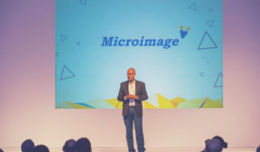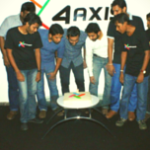It’s a leading provider of HR systems. Its software powers the radio stations and Dialog TV. This is Microimage, Sri Lanka’s most successful college startup that competes with established companies in developed countries.
Recently, Microimage celebrated its 20th anniversary. It’s an important milestone for any company. So how did Microimage achieve this goal? To answer that question, one needs to look at the journey of Microimage from its beginning.
The humble beginnings
The journey of Microimage begins inside the halls of Ananda College. Five friends with a passion for computing formed a club: The Microimage Hobbyists Club. They would spend their days coding various things from games to utilities they needed. One fateful day, they made a breakthrough and everything changed.

The small Microimage club had made the first Sinhala font. They wanted to share this breakthrough with the world. So, the members of the Microimage Club presented their Sinhala fonts to Chinthaka Wijewickrama, the man who would become the chairman of FITIS.
Chinthaka was so impressed that he gave the members of the Microimage club a stall at Infotel. The members of the Microimage had struck gold and presented their Sinhala fonts to the world that was in awe at what a bunch of school kids had accomplished.
With most stories, this would have been the end of it but not with Microimage. The team started to receive many orders for their Sinhala fonts, so they decided to set up a business.
THE ONLY KNOWLEDGE I HAD WHEN WE STARTED WAS O/L COMMERCE
Harsha Purasinghe
In 1993, Microimage Computer Systems was born as a partnership at the house of the enigmatic Harsha Purasinghe. Just one year later, this young startup was incorporated as Microimage (Pvt) Ltd. with its first office located in Nugegoda. At this time, Microimage had 3 students as full-time employees with the rest joining them after school due to A/L’s.
At the time, no one would have known that this was the birth of Sri Lanka’s 1st college startup that would go on to revolutionize the IT industry. Microimage had an amazing product, but the road ahead would be long and challenging.
Overcoming challenges as a young startup
While Microimage’s Sinhala fonts were popular, the young startup had to face tough challenges. Today any startup has easy access to funding thanks to various sources such as angel investors. However back in the 90’s none of these existed. As Harsha describes, “There were no angel investors. The banks didn’t even care about us. This was our startup ecosystem.”
The 90’s being a dark time for Sri Lanka made things even worse. With a bloody civil war raging, people were leaving the country, power cuts were long and one could not travel anywhere without worrying about bomb blasts. One of these deadly bomb blasts nearly destroyed Microimage.
As 2 members of the Microimage team went to make their pitch to the banks, a suicide bomber detonated a lorry full of explosives. The day was January 31st, 1996 and would be forever remembered as the day of the Central Bank Bombing. In this gruesome terrorist attack, 91 innocent people were killed.
In a time without Twitter or Facebook to relay news instantly, the Microimage team feared the worst and thought their comrades were among the fallen. Harsha described the moment saying, “We thought that this is it. We are done. It’s over.”
As the Microimage team was about to call it quits, the 2 team members who had gone to the banks showed up alive and well. The entire team was overjoyed to see their comrades had survived. Having found new energy, the Microimage team faced their challenges head-on.
Microimage went on to rebrand their Sinhala fonts as Helawadana and it found immense popularity in government institutions and local language users. It was even being sold at Majestic City.

Unlike today, in the 90’s having your product being sold at Majestic City was akin to finding a goldmine. The shop that agreed to sell Helawadana was another young startup called EPSI Computers led by the brothers Niranjan Canagey and Muhunthan Canagey, who would both go on to revolutionize the Sri Lankan IT industry alongside Microimage and Harsha.
By the end of 1996, Microimage had it made. Its Sinhala fonts were a hit. So what made this young startup suddenly go into making HR systems? There’s an interesting tale to that.
Trying to build HR Systems
In 1997, Microimage got an opportunity to build a time attendance software from a leading manufacturing company in Sri Lanka. Despite never having built anything like it, they accepted the challenge.
They conquered the challenge and by 1999, Microimage was the leading provider of automated time attendance and payroll software solutions. However, they didn’t let this newfound glory go to their heads. As the new millennium dawned, Microimage built Sri Lanka’s 1st web-based HRIS in 2000. In 2001, this system would become the HR Platform used by Sri Lanka’s 1st GSM operator: Dialog GSM.

By 2002, Microimage had moved into the corporate market with the 1st Sri Lankan web-based HR system. The move was, of course, not without its challenges. Whenever the Microimage team pitched their system they always encountered doubters who threw various questions at them. According to Suren Rupasinghe, COO of Microimage, one common question was, “So what do you know about HR?”
Once again, Microimage stood their ground against the naysayers. They continued to upgrade the Microimage HCM platform and in 2005 acquired their first overseas client in the Maldives. In 2013, Microimage HCM became the HR solution of choice for 300 companies across 10 countries.
IN 1997 A COMPANY REJECTED US. 10 YEARS LATER THEY BOUGHT OUR PRODUCTS, PAYING 20 TIMES MORE
Harsha Purasinghe
The naysayers and doubters were proven wrong, with some paying a hefty price. Microimage’s journey into the realm of HR software is an interesting one.
Conquering the media industry
In 2003, as Microimage was solidifying itself as a leading provider of HR Solutions an accident occurred. ABC Radio Networks approached Microimage and asked them to build a Radio Automation Solution for one of their stations.
This was a time when foreign software was the norm. Accepting this project would have meant that Microimage would have a very high-risk project on their hands. Microimage accepted the challenge and built an impressive prototype. This was the birth of Microimage mStudio, a complete software platform that can run an entire radio station on its own.
After some fine-tuning, mStudio was ready to face the world. In 2004, SunFM officially went live at midnight with the new mStudio platform. Nobody believed that such a feat could have been accomplished by a Sri Lankan company. Once again Microimage had proved everyone wrong.
The focus then shifted to maintenance with various updates that ensured mStudio would be running smoothly.
The young startup had now grown into a large company with a strong foothold in 2 industries. A bit too large. The decision was made to spin off the mobile and media arms of Microimage into a separate subsidiary.
Thus in 2007, Microimage Mobile Media was born. Just a year later, the MBC network wanted an upgraded version of mStudio. After sorting out the legal issues with ABC, mStudio 2.0 was born and went live on all MBC radio channels. At the same time, Microimage had decided to venture into video broadcasting and unveiled its vStation platform.
Fast forward to 2009 and this new subsidiary got its big break. Dialog had decided to implement vStudio to insert ads into Dialog TV broadcasts. At the same time, Microimage Media invited skeptical but potential clients from Broadcast Asia.
The clients had doubts as to whether software rivaling established platforms from the US and Europe actually existed in Sri Lanka. However, after a successful presentation of mStudio in action, Broadcast Asia was sold. This is how mStudio ended up powering Radio Television Malaysia and Kristal FM in Brunei.
Microimage had built a successful subsidiary that was now taking on established media companies across the world. At the same time, it was also innovating at home. In 2012, Microimage Mobile Media entered into a partnership with Etisalat & MD Gunasena to launch BookHub which was Sri Lanka’s first eBook platform. Let’s not forget Thaala which was Sri Lanka’s first legal music streaming platform.
Making a social impact
By now, it’s clear that Microimage was slowly but surely becoming known for making great software in their domains. However, what’s not well known even today is that Microimage is also a social innovator.
This chapter in Microimage history begins in 2004. The devastating Indian Ocean tsunami had struck the country, killing thousands. Harsha believed that action was needed and that technology had the power to save countless lives if such a devastating event should ever occur again. As he soon found out, he wasn’t the only one that felt this way.

As a result, Microimage entered into a partnership with Dialog and the Dialog University of Moratuwa Research Lab. In 2006, this partnership unveiled DEWN to the world. DEWN is a world-class early warning system that alerts the general public via SMS and special alarm devices.
Despite being released in 2006, the system was not fully operational until 2009. This was due to the fact that there was no public institution dedicated to disaster management in 2006. It was only in 2009 that the Ministry of Disaster Management was set up and the system was handed over to them.
Microimage today and plans for the future
On the 7th of October 2015, Microimage celebrated its 20th anniversary. From its humble beginnings as a club inside the halls of Ananda College, Microimage has come a long way. It has ventured into different industries and found success in all of them overcoming great challenges.
So where exactly does Sri Lanka’s most successful college startup stand today? As a massive holding company called Microimage Holdings (Pvt) Limited, with subsidiaries in various industries.

Today, Microimage HCM has 600+ clients across 12 countries in countless industries. The company now aims to further expand into Southeast Asia. To achieve this goal, it has partnered with the OMESTI group to launch a new venture called Microimage HCM Asia which will be based in Kuala Lumpur.
Speaking at the 20th-anniversary celebrations, Mah Xian Zhen, Executive Director of OMESTI conveyed her appreciation for the effort and plans the Microimage team has to enter Southeast Asian Countries like Cambodia, Thailand, Myanmar, and Indonesia.
Furthermore, Harsha also announced that the Microimage HCM platform would be getting a massive update. Dubbed HCM15, the new update brings a redesigned user interface, and a bunch of new features and will be available from Q1 2016.
As for Microimage Mobile Media, it will be releasing mStudio 3.0 in the near future. According to Harsha, this latest release would make radio digital, visual, and social. The subsidiary had also invested in Antyra Solutions.
However, the biggest announcement regarding Microimage’s future at its 20th-anniversary celebrations was the announcement of a new subsidiary: Microimage Impact.
This new member of the Microimage family would be the social enterprise that will focus on making the largest social impact possible. Furthermore, all revenue generated by Microimage Impact will be used to revitalize ideas, that have a social impact utilizing the power of technology. The reason for this new social enterprise according to Harsha is that Microimage already has ventures making profits, now it needs one that will focus on sustaining our world.
Going forward, Microimage also plans to open offices in Sydney, Australia, and Dubai. In just 20 years, Microimage has seen massive success in various ventures. At its 30th anniversary, we’ll probably have even more success stories to write about the little club inside Ananda College that went on to become a titan of the Sri Lankan IT industry.







Never, knew Srilanka has such brilliant companies in HRtech space. Will definitely check out their offerings and what value they bring to Recruitment.